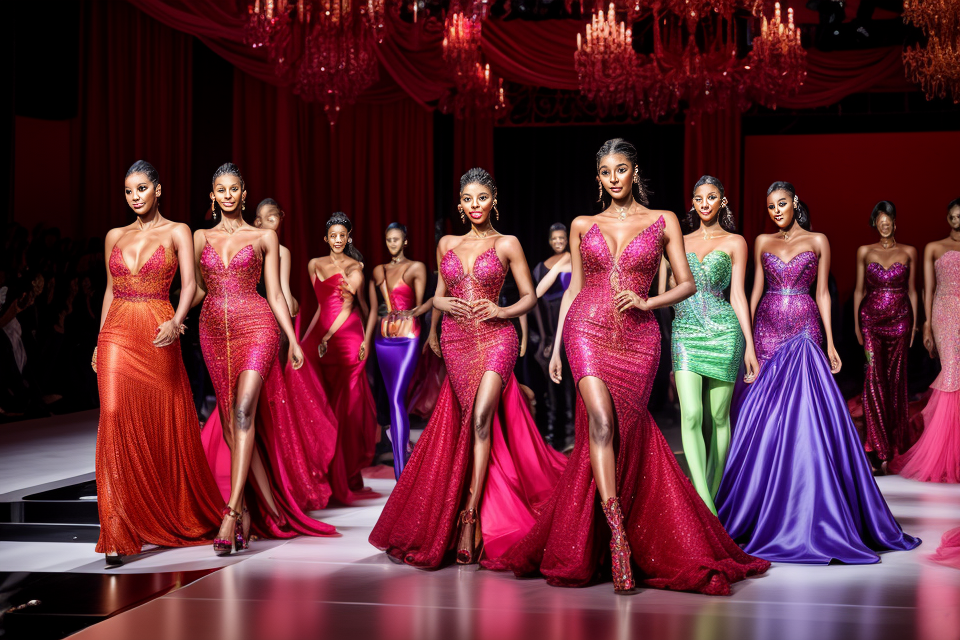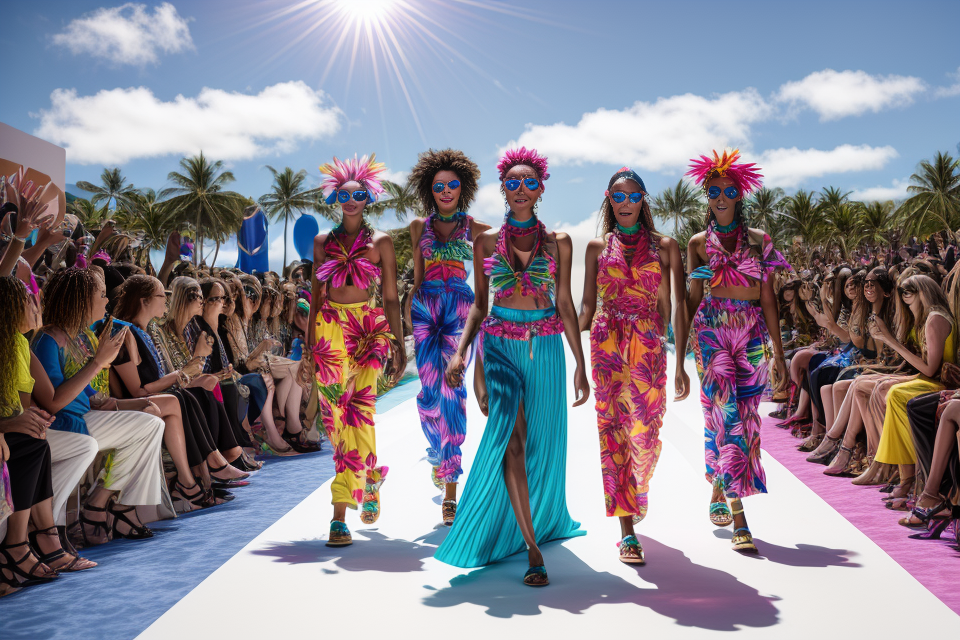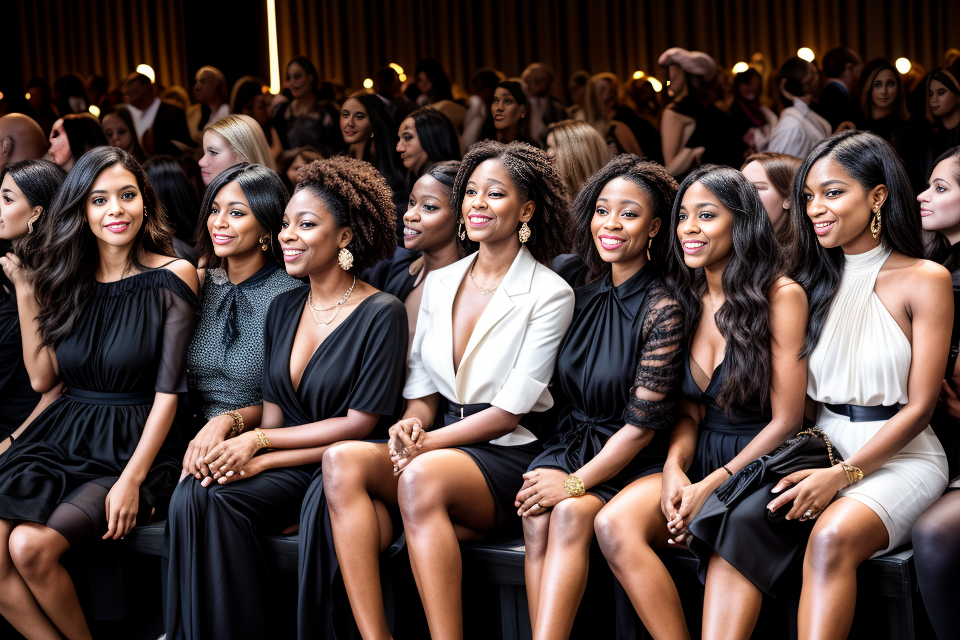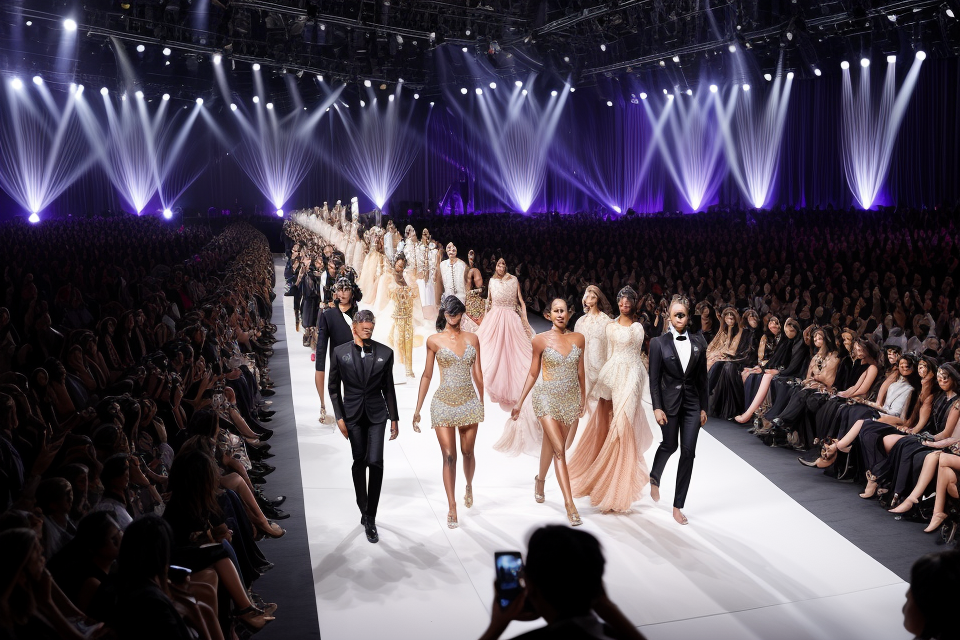
The world of fashion is abuzz with excitement as the biggest and most prestigious fashion shows take center stage. From New York to Paris, London to Milan, these events are the ultimate showcase of style, creativity, and innovation. But which fashion show reigns supreme? In this comprehensive look at the industry’s biggest events, we’ll explore the history, significance, and impact of the most iconic fashion shows in the world. Get ready to discover which one takes the crown as the most sought-after event in the fashion industry.
The Biggest Fashion Shows in the World
The Met Gala
The Met Gala, also known as the Costume Institute Gala, is one of the most prestigious and highly anticipated events in the fashion industry. Held annually on the first Monday in May, the Met Gala marks the grand opening of the Metropolitan Museum of Art’s annual fashion exhibition. The event brings together some of the biggest names in fashion, entertainment, and culture, making it a hotspot for designer collaborations and celebrity sightings.
Overview of the Met Gala
The Met Gala is a black-tie event that takes place at the Metropolitan Museum of Art in New York City. It is organized by the museum’s Costume Institute and serves as a fundraiser for the institution. The event is known for its high-profile attendees, extravagant fashion, and celebrity collaborations. The Met Gala has become a significant platform for designers to showcase their creativity and for celebrities to make a fashion statement.
Significance of the Met Gala in the fashion industry
The Met Gala is widely regarded as the Super Bowl of fashion. It is a crucial event for designers, fashion editors, and influencers to showcase their style and for emerging designers to gain exposure. The Met Gala also sets the tone for the upcoming fashion season, with designers showcasing their latest collections and trends. The event has a significant impact on the fashion industry, and it is often referred to as the “Oscars of fashion.”
History of the Met Gala
The Met Gala has a rich history dating back to 1948, when it was first held as a small event to raise funds for the Costume Institute. Over the years, the event has grown in size and stature, attracting high-profile attendees and gaining widespread media attention. In recent years, the Met Gala has become a social media sensation, with celebrities and designers using the event to make a statement and gain exposure.
Celebrity attendees and designer collaborations
The Met Gala is known for its high-profile attendees, who are often dressed in custom-made designer gowns. Celebrities, models, and influencers flock to the event, making it a hotspot for fashion and celebrity culture. The Met Gala also provides an opportunity for designers to collaborate with celebrities, creating buzz and generating media coverage. Some of the most iconic Met Gala looks have been created through designer-celebrity collaborations, including Rihanna’s papal-inspired gown by Maison Margiela and the “Comme des Garçons” dress worn by Sarah Jessica Parker.
In conclusion, the Met Gala is a significant event in the fashion industry, serving as a platform for designers to showcase their creativity and for celebrities to make a fashion statement. The event has a rich history and has become a hotspot for high-profile attendees, designer collaborations, and media coverage.
The Victoria’s Secret Fashion Show
The Victoria’s Secret Fashion Show is one of the most highly anticipated events in the fashion industry. Here’s a closer look at what makes this show so significant.
Overview of the Victoria’s Secret Fashion Show
The Victoria’s Secret Fashion Show is an annual event held by Victoria’s Secret, a lingerie and beauty retailer. The show features models wearing the brand’s latest lingerie and beauty products, as well as performances by celebrities and musical guests.
Significance of the Victoria’s Secret Fashion Show in the fashion industry
The Victoria’s Secret Fashion Show is significant in the fashion industry for several reasons. Firstly, it is one of the most-watched fashion events in the world, with millions of viewers tuning in to watch the show each year. This provides a massive platform for the brand to showcase its products and for models to gain exposure.
Secondly, the show is known for its elaborate sets, costumes, and choreography, making it a highly anticipated spectacle. It also features collaborations with top designers and celebrities, further increasing its profile and significance in the industry.
History of the Victoria’s Secret Fashion Show
The Victoria’s Secret Fashion Show has a long history dating back to 1995, when it was first held in New York City. Since then, the show has been held in various locations around the world, including Los Angeles, Paris, and Shanghai.
Over the years, the show has evolved and expanded, with more elaborate sets, costumes, and performances. It has also become known for its celebrity performers and guests, including the likes of Rihanna, Taylor Swift, and Katy Perry.
Designer collaborations and celebrity performances
One of the most exciting aspects of the Victoria’s Secret Fashion Show is the collaboration between the brand and top designers. Each year, the show features collaborations with a range of designers, from established names to up-and-coming talents.
In addition to designer collaborations, the show also features performances by celebrities and musical guests. These performances are often highly anticipated and help to increase the show’s profile and reach.
Overall, the Victoria’s Secret Fashion Show is a significant event in the fashion industry, known for its elaborate productions, high-profile collaborations, and celebrity performances.
The Paris Haute Couture Fashion Week
The Paris Haute Couture Fashion Week is one of the most prestigious and highly anticipated events in the fashion industry. It is a bi-annual event that takes place in Paris, France, and showcases the latest designs from the world’s top haute couture designers.
Significance of the Paris Haute Couture Fashion Week in the fashion industry
The Paris Haute Couture Fashion Week is considered to be the pinnacle of fashion events, and it holds significant importance in the fashion industry. It is a platform for designers to showcase their latest collections and to establish themselves as leaders in the industry. The event is also a major influencer in setting fashion trends and dictating the direction of the industry.
History of the Paris Haute Couture Fashion Week
The Paris Haute Couture Fashion Week has a rich history dating back to the 19th century. It was initially a means for couturiers to showcase their latest designs to clients and buyers. Over time, the event has evolved and expanded, and it now features a wide range of designers and brands from around the world.
Designer showcases and fashion trends
The Paris Haute Couture Fashion Week is known for its high-end, luxury designs and its showcase of the latest fashion trends. Designers showcase their latest collections through runway shows, presentations, and installations, and they often incorporate innovative materials, techniques, and designs into their work. The event also attracts celebrities, influencers, and other fashion industry professionals, making it a highly visible and influential platform for designers to showcase their work.
The Most Influential Fashion Shows
The New York Fashion Week
The New York Fashion Week, held twice a year in February and September, is one of the most influential fashion events in the world. It is a week-long series of runway shows, presentations, and events showcasing the latest collections of international designers.
Overview of the New York Fashion Week
The New York Fashion Week is a premier event in the fashion industry, showcasing the latest trends and designs from established and emerging designers. It is attended by industry professionals, fashion buyers, journalists, celebrities, and other fashion enthusiasts.
Significance of the New York Fashion Week in the fashion industry
The New York Fashion Week is a significant event in the fashion industry as it sets the tone for the upcoming season. It is an opportunity for designers to showcase their creativity and innovation, and for buyers and media to preview the latest collections. The event also generates significant media coverage and helps to establish designers’ brand identity.
History of the New York Fashion Week
The New York Fashion Week has a rich history dating back to the 1940s when it was first held as a small event showcasing the collections of a few local designers. Over the years, it has grown in size and stature, and today it is one of the most important events in the global fashion industry.
The New York Fashion Week is a platform for designers to showcase their latest collections and introduce new trends. Designers use the event to showcase their unique style and vision, and to attract the attention of buyers, media, and consumers. The event is also an opportunity for fashion enthusiasts to discover new designers and trends.
In summary, the New York Fashion Week is a significant event in the fashion industry, showcasing the latest collections of international designers and setting the tone for the upcoming season. It is a platform for designers to showcase their creativity and innovation, and for buyers and media to preview the latest trends and designs.
The London Fashion Week
Overview of the London Fashion Week
The London Fashion Week is one of the most highly anticipated events in the fashion industry. It is a week-long celebration of fashion, showcasing the latest designer collections and trends. The event is held twice a year, in February and September, and is attended by industry professionals, buyers, journalists, and celebrities from around the world.
Significance of the London Fashion Week in the fashion industry
The London Fashion Week is a crucial event in the fashion industry as it provides a platform for designers to showcase their collections and gain exposure. It is also an opportunity for buyers to place orders for the upcoming season and for journalists to cover the latest trends and designs. The event has a significant impact on the fashion industry as a whole, influencing the direction of fashion and setting the tone for the upcoming season.
History of the London Fashion Week
The London Fashion Week has a rich history dating back to the 1950s. It started as a small event showcasing the work of British designers and has since grown into a global event attracting designers and buyers from around the world. Over the years, the event has evolved to include a wider range of designers and styles, reflecting the diversity and creativity of the fashion industry.
The London Fashion Week is known for its diverse range of designer showcases, featuring both established and emerging designers. The event provides a platform for designers to showcase their creativity and innovation, often introducing new trends and styles that influence the fashion industry as a whole. From haute couture to streetwear, the London Fashion Week offers a glimpse into the future of fashion and what can be expected in the upcoming season.
Overall, the London Fashion Week is a significant event in the fashion industry, providing a platform for designers to showcase their collections and for buyers and journalists to gain insight into the latest trends and styles. Its rich history and diverse range of showcases make it a must-attend event for anyone in the fashion industry.
The Milan Fashion Week
The Milan Fashion Week is one of the most prestigious and influential fashion events in the world. Held twice a year, in February and September, it showcases the latest collections of top designers from Italy and around the globe.
Overview of the Milan Fashion Week
The Milan Fashion Week is a week-long event that brings together fashion designers, buyers, journalists, and influencers from all over the world. It is held at various venues throughout Milan, including the famous Milan Fashion Week Pavilion, which is located in the heart of the city.
Significance of the Milan Fashion Week in the fashion industry
The Milan Fashion Week is considered one of the “Big Four” fashion weeks, along with Paris, London, and New York. It is a critical event for designers to showcase their latest collections and for buyers to place orders for the upcoming season. The event also sets the tone for the global fashion industry and influences trends and styles for the next season.
History of the Milan Fashion Week
The Milan Fashion Week has a rich history dating back to the 1950s, when it was first held as a small event for Italian designers to showcase their collections. Over the years, it has grown in size and stature, becoming one of the most important fashion events in the world.
The Milan Fashion Week is known for its glamorous runway shows, where top designers showcase their latest collections. The event is also a platform for emerging designers to showcase their work and gain recognition in the industry. The collections presented at the Milan Fashion Week often set the tone for fashion trends and styles for the upcoming season.
The Future of Fashion Shows
The Impact of Technology on Fashion Shows
In recent years, technology has had a profound impact on the fashion industry, and fashion shows are no exception. From virtual fashion shows to augmented reality experiences, technology is transforming the way designers showcase their collections and connect with audiences.
Overview of the impact of technology on fashion shows
Technology has revolutionized the way fashion shows are produced and experienced. With the rise of social media and online platforms, designers now have the opportunity to reach a global audience, regardless of their location. Additionally, technology has enabled designers to create more immersive and interactive experiences for their audiences, pushing the boundaries of what a fashion show can be.
Virtual fashion shows and their benefits
Virtual fashion shows have become increasingly popular in recent years, allowing designers to showcase their collections in a digital format. Virtual fashion shows offer several benefits, including lower costs, increased accessibility, and reduced environmental impact. They also allow designers to reach a wider audience and provide a more immersive experience for viewers.
Augmented reality and its potential in fashion shows
Augmented reality (AR) has the potential to transform fashion shows by allowing audiences to experience the collection in a more interactive and immersive way. AR technology can be used to create virtual runway shows, allowing viewers to see the collection come to life in real-time. It can also be used to create interactive experiences, such as virtual try-on, which can enhance the overall viewer experience.
Challenges and limitations of virtual and augmented reality fashion shows
While virtual and augmented reality fashion shows offer several benefits, there are also challenges and limitations to consider. One of the main challenges is the need for high-quality technology and specialized equipment, which can be costly. Additionally, virtual and augmented reality experiences can be isolating, as they are often experienced alone, rather than in a social setting. Finally, there is the risk of technology malfunctions, which can disrupt the overall experience.
Despite these challenges, the impact of technology on fashion shows is undeniable, and it is likely to continue to play a significant role in the industry for years to come. As technology continues to evolve, we can expect to see even more innovative and immersive fashion show experiences in the future.
Sustainability and Ethics in Fashion Shows
As the fashion industry continues to evolve, sustainability and ethics have become increasingly important aspects of fashion shows. Designers and brands are under pressure to adopt more sustainable and ethical practices in order to meet the demands of environmentally and socially conscious consumers.
Environmental and Social Concerns in Fashion Shows
Fashion shows have long been criticized for their environmental impact, including the excessive use of water, energy, and materials in the production of clothing and the resulting waste. Additionally, there are concerns about the labor practices and human rights violations that occur in the supply chains of many fashion brands.
Sustainable and Ethical Practices in Fashion Shows
In response to these concerns, many fashion shows are making efforts to become more sustainable and ethical. This includes using eco-friendly materials, reducing waste, and implementing fair labor practices. Some designers are also using their platforms to raise awareness about environmental and social issues, such as climate change and human trafficking.
Future Trends in Sustainable and Ethical Fashion Shows
As the demand for sustainable and ethical fashion continues to grow, it is likely that we will see more fashion shows adopting these practices in the future. This may include using entirely sustainable materials, partnering with ethical suppliers, and incorporating circular economy principles into their designs. Additionally, we may see more fashion shows using technology to create more sustainable and ethical products, such as using 3D printing to reduce waste.
The Post-Pandemic Fashion Show Landscape
The COVID-19 pandemic has undoubtedly left an indelible mark on the fashion industry, including the way fashion shows are conducted. With lockdowns and social distancing measures disrupting traditional fashion show formats, the industry has had to adapt to new norms. This section explores the post-pandemic fashion show landscape, highlighting changes in fashion show formats and locations, the impact of the pandemic on fashion show attendance and viewership, and future trends in post-pandemic fashion shows.
Changes in Fashion Show Formats and Locations
One of the most significant changes in the post-pandemic fashion show landscape is the shift in formats and locations. Traditional runway shows have given way to digital presentations, with designers showcasing their collections through videos, livestreams, and virtual reality experiences. Some designers have even opted for smaller, more intimate shows, such as pop-up shows and presentations in non-traditional venues like museums or galleries.
Furthermore, with travel restrictions and concerns about large gatherings, fashion shows have become more localized, with designers showing their collections in their home cities or countries rather than traveling to international fashion capitals like Paris, Milan, and New York. This shift has led to a more diverse range of designers and brands being featured in fashion shows, as well as a greater focus on regional styles and trends.
Impact of the Pandemic on Fashion Show Attendance and Viewership
The pandemic has also had a significant impact on fashion show attendance and viewership. With lockdowns and social distancing measures in place, physical attendance at fashion shows has been limited, resulting in a decline in ticket sales and sponsorship revenue. At the same time, online viewership has increased, with more people tuning in to watch fashion shows online.
This shift towards digital viewership has created new opportunities for designers and brands to reach wider audiences, as well as new challenges in terms of engaging viewers and measuring success. With the rise of social media and online fashion publications, fashion shows have become more democratized, with a wider range of voices and perspectives being represented in the fashion media landscape.
Future Trends in Post-Pandemic Fashion Shows
Looking ahead, the post-pandemic fashion show landscape is likely to continue evolving, with a greater emphasis on digital experiences and localized shows. Designers and brands will need to be more creative and innovative in their approaches to fashion shows, leveraging technology and social media to engage with audiences and build brand awareness.
At the same time, there will be a greater focus on sustainability and ethical practices in fashion shows, with designers and brands looking to reduce their environmental impact and promote more responsible and equitable practices in the industry. This includes using sustainable materials, reducing waste, and promoting diversity and inclusivity in fashion shows.
Overall, the post-pandemic fashion show landscape is a rapidly changing one, with new challenges and opportunities emerging for designers and brands. As the industry continues to adapt to new norms, it will be fascinating to see how fashion shows evolve and what new trends emerge in the years to come.
FAQs
1. What is the biggest fashion show in the world?
The biggest fashion show in the world is arguably the Met Gala, which is held annually in New York City. The Met Gala, also known as the Costume Institute Gala, is a fundraising event for the Metropolitan Museum of Art’s Costume Institute. It is considered one of the most prestigious events in the fashion industry, attracting top designers, celebrities, and industry insiders from around the world.
2. What other fashion shows are considered major events in the industry?
There are several other fashion shows that are considered major events in the industry, including:
* Paris Fashion Week: This is one of the most highly anticipated events in the fashion industry, attracting designers, buyers, and media from around the world. It is held twice a year, in February and September, and features shows from top designers such as Chanel, Dior, and Saint Laurent.
* Milan Fashion Week: This event is held twice a year, in February and September, and is known for its high-end luxury fashion shows. It features top designers such as Gucci, Prada, and Versace.
* London Fashion Week: This event is held twice a year, in February and September, and features shows from a range of British and international designers. It is known for its focus on emerging talent and innovative design.
3. What makes a fashion show a major event?
There are several factors that can make a fashion show a major event, including:
* The reputation of the designer or brand hosting the show
* The level of media coverage and attention the show receives
* The number of industry insiders, buyers, and celebrities in attendance
* The level of creativity and innovation in the designs shown
* The overall impact and influence of the show on the fashion industry
4. How has the COVID-19 pandemic affected fashion shows?
The COVID-19 pandemic has had a significant impact on the fashion industry, including fashion shows. Many fashion shows were cancelled or postponed in 2020 and 2021 due to concerns about the spread of the virus. Some designers opted to hold virtual shows or present their collections through digital platforms. As the situation with the pandemic continues to evolve, it is likely that fashion shows will continue to be impacted in some way.


